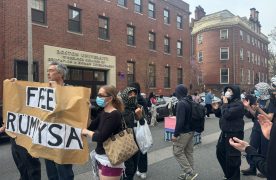In Massachusetts, all public school districts are required to start conducting fully in-person learning, and all elementary schools are expected to be in-person by May 3.
But a question lingers in the minds of those who know how unhygienic children can be: What does it mean to send them back in person before the COVID-19 vaccine has been approved for adolescent and child use?
It’s unclear as of yet how long children will be in school unvaccinated. In February, White House chief medical adviser Anthony Fauci said children as young as six or seven years old may have access to the vaccine by fall.
This month, Fauci said middle and high schoolers could be vaccinated by fall, but younger children would probably have to wait until early 2022. Evidently, the timeline is still shifting according to the progress of vaccine trials.
Fortunately, pediatric vaccine trials are beginning to pick up the pace.
But children may be contracting the virus in the meantime. Despite the belief that children are less likely to be infected by the coronavirus, the infection rates are actually equivalent to those in adults. In the United States, children make up 12.9% of reported cases of the virus.

While most children who have had COVID-19 have displayed minimal to no symptoms, a rare medical condition called Multisystem Inflammatory Syndrome has caused severe illness in a small percentage of kids. Furthermore, children who have underlying conditions — such as asthma, sickle cell, immunosuppression and diabetes — are more susceptible to the disease.
Children also typically run higher fevers than adults, and temperatures above 102 degrees can be dangerous for younger kids.
Even without the health risks, it may be easier for unvaccinated children, who will spend prolonged time with other unvaccinated peers, to become asymptomatic carriers. For family members, teachers or other adults at the school who have not yet been inoculated or have pre-existing conditions, this is an additional concern.
However, returning to school is an important step and one that’s necessary for children’s development. We have suffered through a long year of isolation and social distancing, meaning children have spent 12 months developing with limited cognitive and social stimulation. They have missed out on the face-to-face connections, formative friendship years and potentially major milestones.
Instead, these experiences in society have been replaced by blue-light screens, face masks and undue stress, which could delay brain development.
As college students, we too have felt the impact of Zoom fatigue and screen burnout. Imagine what that behavior can do to a young brain — one that’s already so heavily immersed in a high-technology world, surrounded by smartphones and iPads.
We must take into consideration the mental, emotional and social health impact of the pandemic alongside the physical health component. It is absolutely crucial to give children a sense of normalcy and allow them to reclaim their childhood and education.
Furthermore, schools in Massachusetts will have masks and social distancing. Though we have to be careful these measures are enforced and children are monitored by schools, this aspect should be feasible.
Kids may walk around outside maskless, but their minds are also malleable and open to different ideas and beliefs — arguably more so than adults. If schools require masks and teachers explain to students why it’s important, they will be able to understand and want to follow the rules, thus diminishing the risk of transmission.
For immunocompromised children or those who could potentially act as carriers, the United States is projected to reach approximate herd immunity by this summer.
But this prediction may not be entirely accurate or feasible. We don’t know what the percentage required for COVID-19 herd immunity is yet, though it’s estimated to be between 70% to 95%. It is made considerably more difficult considering children — who make up more than one-fifth of the U.S. population — are not yet eligible. Further complications include vaccine hesitancy and new strains of the virus.
Hopefully, once we near herd immunity or even achieve it, the protection may keep the more vulnerable children safe, especially as we continue with cautionary, preventive measures. All students, including those who are immunocompromised, will continue to be able to attend remotely even after schools reopen.
When the vaccine does become available to children, schools can and should mandate COVID-19 vaccines, similarly to flu vaccines in Massachusetts.
It may be slightly premature to return to in-person learning now since vaccines haven’t become available to the general public, but as more and more adults are inoculated, children should definitely be given the chance to regain some semblance of a normal childhood.
While there are risks associated with opening schools back up and putting unvaccinated children in a room together, advancing the social and emotional development and mental well-being of the next generation is too important to halt any longer.














